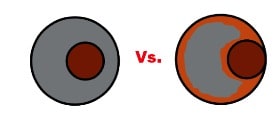Introduction:
Before we cover the ways that we can mitigate the risk of an annular pack off while cementing, first we can cover the actions that lead to this outcome. Insufficient hole cleaning before cementing means that cuttings and solids remain in the hole by the time we execute the cementing operation. This situation is of particular concern due to the higher carrying capacity of the cementing fluids (spacer and cement slurries).
During the cementing operations, all these solids and cuttings will be carried up in the annulus mixing with the spacer and lead cement slurry. Depending on the number of solids, this effect will produce increased friction. Eventually, complete plugging or packing off the annular space will occur, preventing any further flow, potentially leaving a long column of cement slurries under-displaced inside the casing.
Preventing the condition at all, by proper drilling practices and hole cleaning techniques, is the best solution. If an annular pack-off risk still exists before cementing, we can consider the following measures as mitigation:
– Centralization to avoid annular pack off.
o Do not be too optimistic about the number of centralizers. Centralizers in the washout areas would have a minor or insignificant contribution to improve the stand-off. They can also increase the likelihood of an annular pack off by mechanically weakening sensitive borehole areas (usually near the washouts).
o If pipe reciprocation is considered, centralizers must be allowed to move freely at least half joint. This will also limit any abrasive action on sensitive areas of the borehole
– Circulation before cementing (casing on bottom)
o Simulate, with software, the expected circulating surface pressure at different rates. These values would provide a reference to identify when the hole is conditioned.
o Identify any erratic behavior of the pumping pressure; continue circulation until mostly removed while continually monitoring the shakers. Determine extended circulation time to ensure that the hole is clean before cementing.
o We need to define the properties of the mud before cementing, by balancing hole stability targets and cement placement. In case mud rheology can be lowered, hole stability permitting, do this only when we establish complete hole cleaning.
– The placement of cementing fluids
o Proper and detailed pre-job planning is mandatory. This will ensure that the crew is fully aware of the planned actions and their role in the cementing operation.
o Do not pump any fluid lighter than the mud, or with lower viscosity, like Newtonian fluids. These fluids would increase the settling of solids and further destabilize the hole.
o Do not pump scavenger slurries. We recommend these slurries in specific circumstances where additional abrasive action ahead of the cement slurry is a benefit. However, if there is a risk of packing off the annulus this effect would be somewhat negative. Additionally, these cement slurries can be extremely unstable, particularly at lower rates.
o Ensure the spacer is stable, i.e. the solids are adequately suspended and fluid rheology is as designed. Proper hydration of bentonite and any other polymer in the formula is of paramount importance.
o Proper density control of cement slurries is considerably critical within this context, and if not correctly done, it can rapidly increase the chances of packing off the annulus. The cement slurry mixed below the designed density is likely to be unstable while the slurry mixed above would likely have shorter gel strength development and thickening time. Both effects would make the situation worse.
o The pumping rate should be as high as possible (within the fracture gradient limit). A high rate ensures annular velocity. (While cementing, pumping is always above the annular velocity estimated from hydraulic software for hole cleaning).
o Reduce the u-tube effect and static periods (dropping plugs) while cementing.
o The volume of the washouts should not be considered for cement slurry volume calculations. The reason for this is because the cement will likely not go inside.
o If possible, prepare proper plans to ensure how reciprocation will be done and maintained during the cement job. We use casing reciprocation as a contingency in case signs of pack-off are seen in combination with the following pumping strategy:
- Erratic behaviour, sudden fluctuation or unstable pumping pressure would likely indicate the possibility of an annular pack off.
- If additionally, the pressure trend is increasing at a faster pace than expected, the conditions for a pack off already exist.
- In this case, do not lower the rate, and even increase it as much as possible, as at this moment the priority is to finalize the displacement of the cement out of the casing.
Cheers
L. Diaz



Leave a Reply